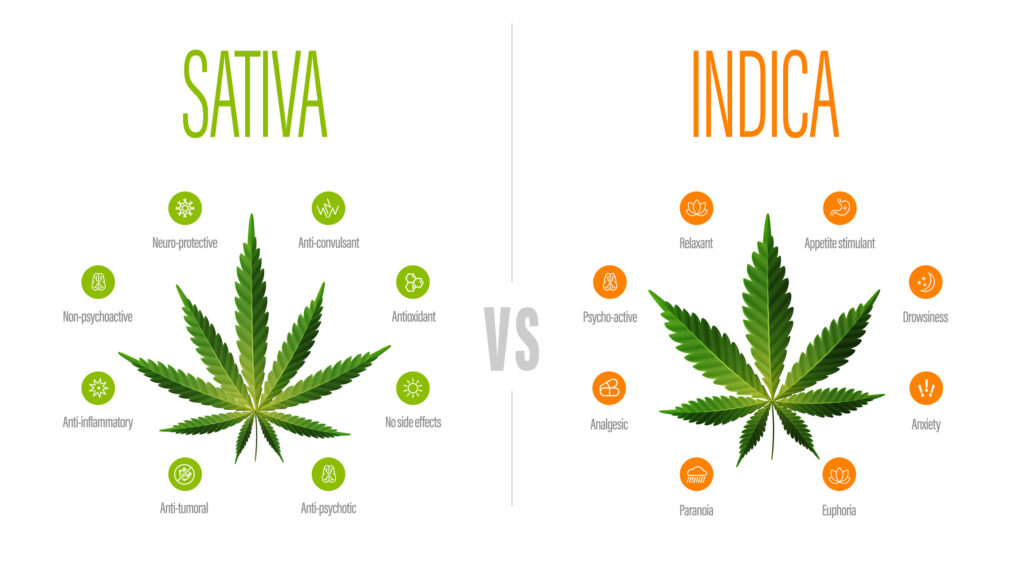Table of Contents
Cannabis has long been classified into two primary categories: Sativa and Indica. These classifications are often used to describe the effects, appearance, and growth patterns of different cannabis strains. The difference between Sativa and Indica will help you better understand the cannabis spectrum. While the Sativa vs. Indica debate has been widely discussed among cannabis enthusiasts, it's essential to understand the key differences between these two types of cannabis plants. In this article, we'll delve into the difference between Sativa and Indica strains, their effects, and how they're commonly used.

Understanding the Difference Between Sativa and Indica
Sativa and Indica are two distinct species within the Cannabis genus, each with unique characteristics. Understanding the differences between sativa and indica can help consumers make informed choices when selecting cannabis strains.
Sativa
Sativa strains are known for their uplifting and energizing effects, making them popular choices for daytime use. These plants typically grow tall and thin, with long, narrow leaves and loose, airy buds. Sativa strains are native to warmer climates and thrive in equatorial regions with long growing seasons.
Key Characteristics of Sativa Strains:
- Energizing Effects: Sativa strains are often associated with cerebral effects that promote creativity, focus, and mental clarity. These strains are favored for daytime use or social gatherings, as they can enhance sociability and stimulate conversation.
- Physical Appearance: Sativa plants grow tall and slender, with branches stretching upward. The leaves are narrow and elongated, and the buds are typically long and cylindrical.
- Aromas and Flavors: Sativa strains often feature fruity, citrusy, or spicy aromas, with flavors ranging from sweet and tropical to earthy and herbal.
Indica
Indica strains are renowned for their relaxing and sedating effects, making them ideal for evening or nighttime use. These plants typically grow shorter and bushier than sativa plants, with broader leaves and dense, compact buds. Indica strains originated in cooler, mountainous regions with shorter growing seasons.
Key Characteristics of Indica Strains:
- Relaxing Effects: Indica strains are prized for their calming and soothing effects, which can help promote relaxation, stress relief, and sleep. These strains often alleviate pain, muscle spasms, and insomnia.
- Physical Appearance: Indica plants have a compact and bushy growth structure, with short, broad leaves and dense, resinous buds. The branches tend to grow close together, creating a lush canopy.
- Aromas and Flavors: Indica strains typically have earthy, woody, or skunky aromas, with flavors ranging from spicy and herbal to sweet and floral.
Hybrid Strains
In addition to Sativa and Indica, hybrid strains combine characteristics of both species. Hybrid strains are created by crossing Sativa and Indica plants, resulting in offspring with a blend of Sativa and Indica traits. Hybrid strains can be classified as Sativa-dominant, Indica-dominant, or balanced, depending on the genetic makeup of the parent plants.
Choosing the Right Strain for You
When selecting a cannabis strain, it's essential to consider your individual preferences, needs, and tolerance levels. Here are some factors to consider when choosing between Sativa and Indica strains:
- Desired Effects: Determine whether you're seeking uplifting, energizing effects (Sativa) or relaxing, sedating effects (Indica). Consider how you plan to use cannabis and the impact you hope to achieve.
- Time of Day: Consider the time of day you plan to consume cannabis. Sativa strains are better suited for daytime use, while Indica strains are ideal for evening or nighttime use.
- Personal Sensitivity: Pay attention to how your body responds to different strains and cannabinoid profiles. Some individuals may find sativa strains too stimulating or anxiety-inducing, while others may prefer the calming effects of Indica strains.
- Terpene Profile: Terpenes are aromatic compounds in cannabis that contribute to its aroma, flavor, and effects. Consider the terpene profile of a strain, as certain terpenes may enhance or modulate the effects of cannabinoids.
Conclusion
While sativa and indica strains have distinct characteristics and effects, it's essential to approach cannabis consumption with an open mind and willingness to experiment. By understanding the differences between Sativa and Indica and considering your individual preferences and needs, you can make informed choices when selecting cannabis strains that align with your desired effects and experiences.




